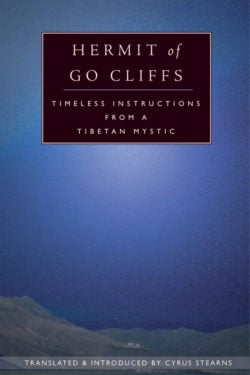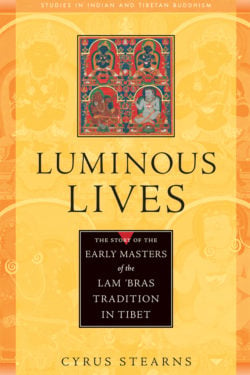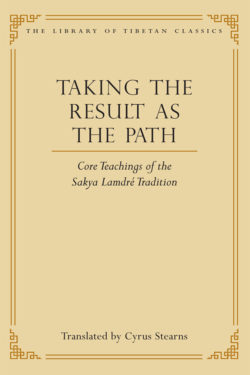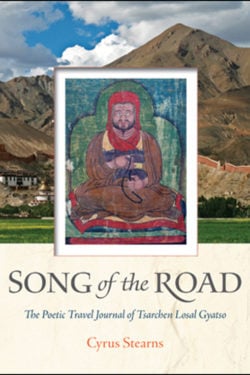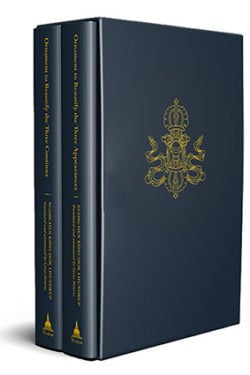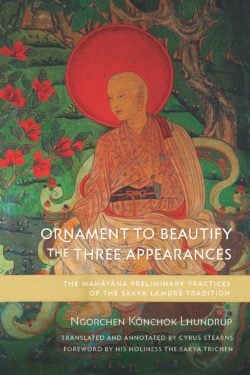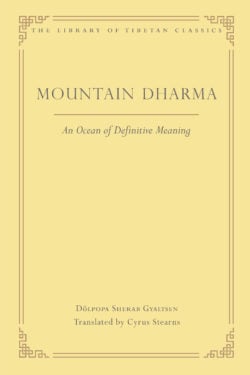Cyrus Stearns

Cyrus Stearns has been a student of Tibetan Buddhism since 1973. His main teachers have been Dezhung Tulku Rinpoché, Chogyé Trichen Rinpoché, and Dilgo Khyentsé Rinpoché. He received a PhD in Buddhist Studies from the University of Washington and is the author and translator of various books, including The Buddha from Dölpo, King of the Empty Plain, and Hermit of Go Cliffs. He is an independent scholar and translator living in the woods on Whidbey Island, north of Seattle, Washington.
Books, Courses & Podcasts
Hermit of Go Cliffs
The great Tibetan meditation master Gyalwa Godrakpa (1170-1249) practiced and taught a nonsectarian approach to realization. Hermit of Go Cliffs is the first English translation of The Collected Songs of Godrakpa, presented here with the original Tibetan text and with Cyrus Stearns’ comprehensive introduction to Godrakpa’s life, legacy, and poetry.
Like the songs of Tibet’s great saint Milarepa, Godrakpa’s songs are uniquely beautiful and accessible: sometimes stern and sharp, sometimes lyrical and filled with allusions to the natural world. These songs express what Godrakpa emphasized in his life—a no-nonsense approach to the practice of meditation.
Read Gyalwa Godrakpa’s biography at the Treasury of Lives.
Luminous Lives
The tantric Buddhist tradition of the Lam ’bras, the “Path with the Result,” has been practiced in Tibet for almost a thousand years, most prominently within the Sakya lineage. Luminous Lives is the first in-depth study of the literature and history of the Lam ’bras in Tibet. The central focus of the work is a rare Tibetan history that brings alive the story of the earliest men and women practitioners of the Lam ’bras. This text, recording the words of the great Sakya Pandita (1182–1251), was a major source for all later histories of the tradition. Recently rediscovered, it has been reproduced here along with Cyrus Stearns’ excellent translation, introduction, and annotations. Luminous Lives opens a window into the world of one of the great traditions of tantric Buddhism in Tibet.
Click here to return to the Studies in Indian and Tibetan Buddhism series.
Read the biographies of Sakya Pandita and Sachen Kunga Nyingpo at the Treasury of Lives.
Taking the Result as the Path
The tradition known as the Path with the Result, or Lamdré‚ is the most important tantric system of meditation practice and theory in the Sakya school of Tibetan Buddhism. This volume contains an unprecedented compilation of eleven vital works from different periods in the history of the Path with the Result in India and Tibet, including the Vajra Lines of the great Indian adept Virūpa (ca. seventh–eighth centuries), the basic text of the tradition. The collection also includes six writings by Jamyang Khyentsé Wangchuk (1524–68) and an instruction manual composed by the Fifth Dalai Lama (1617–62). None of the works in this book have ever been published before in any European language, and most of these writings traditionally have been considered secret. The present translation, an important new volume of the Library of Tibetan Classics, has been made with the personal approval and encouragement of His Holiness Sakya Trizin, head of the Sakya tradition. Students of the Lamdré will rejoice at the availability and lucidity of this major translation of key Sakya texts.
Learn more about the Library of Tibetan Classics
Learn about becoming a benefactor of the Library of Tibetan Classics
Learn more about the following masters at the Treasury of Lives:
Song of the Road
In Song of the Road, Tsarchen Losal Gyatso (1502-66), a tantric master of the Sakya tradition of Tibetan Buddhism, weaves ecstatic poetry, song, and accounts of visionary experiences into a record of pilgrimage to central Tibet. Translated for the first time here, Tsarchen’s work, a favorite of the Fifth Dalai Lama, brims with striking descriptions of encounters with the divine as well as lyrical portraits of Tibetan landscape. The literary flights of Song of the Road are anchored by Tsarchen’s candid observations on the social and political climate of his day, including a rare example in Tibetan literature of open critique of religious power.
Like the Japanese master Basho’s famous Narrow Road to the Interior, written 150 years later, Tsarchen’s travelogue contains a mixture of luminous prose and verse, rich with allusions. Traveling on horseback with a band of companions, Tsarchen visited some of the most renowned holy sites of the Tsang region, incluing Jonang, Tropu, Ngor, Shalu, and Gyantse. In his introduction and copious notes, Cyrus Stearns unearths the layers of meaning concealed in the text, excavating the history, legends, and lore associated with people and places encountered on the pilgrimage, revealing the spiritual as well as geographical topography of Tsarchen’s journey.
The Preliminary and Main Practices of the Sakya Lamdré Tradition
This beautiful box set contains translations of two major works written by Ngorchen Könchok Lhundrup (1497–1557) to explain the teachings of the Lamdré, or Path with the Result, the most precious system of tantric theory and practice in the Sakya tradition of Tibetan Buddhism. Both volumes are translated by Cyrus Stearns with a foreword by His Holiness the Sakya Trichen. The first volume is also available as a standalone book, and the teachings within it may be practiced by anyone, without specific, required preparation. Because the second volume explains Vajrayāna practices that require specific preparation, this is a restricted box set intended only for students who have at least received the great initiation of Hevajra.
The first volume, Ornament to Beautify the Three Appearances, explains the preliminary practices of the Lamdré. The guiding instructions on impure appearance are for the purpose of developing renunciation. These focus on the defects of saṃsāra; the rarity, benefit, and transience of human life; and the nature of positive and negative actions and results. The guiding instructions on the appearance of the experiences are for the purpose of producing the altruistic intent. These focus on developing love, compassion, and bodhicitta and cultivating joy now about the uncommon experiences that will arise later when practicing the Vajrayāna teachings. The guiding instructions on pure appearance are for the purpose of producing enthusiasm for the ultimate result of complete awakening. These briefly describe the inconceivable nature of a buddha’s enlightened body, speech, and mind.
The second volume, Ornament to Beautify the Three Continua, explains the main tantric practices of the Lamdré. To study, reflect, and meditate on these, a person must first receive the Hevajra initiation and keep the sacred commitments. Three main topics are presented: the cause, the path, and the ultimate result. To understand that the abiding mode of saṃsāra is not beyond the appearances of the mind, or the universal ground (since all the phenomena of saṃsāra and nirvāṇa are complete within the mind), the causal continuum of the universal ground is taught. To understand the essence of the path that is to be practiced, the precise way to meditate is taught. Moreover, to understand that the key points of the body must be targeted, the method continuum of the body is taught. To realize the essence of the result, the level of buddhahood is determined.
Dependent on the causal continuum of the universal ground, which is like a field, being purified by the method continuum of the body, which is like water and manure, the resultant continuum of mahāmudrā (the four resultant kāyas), which is like the ripened fruit, is actualized.
The first volume from this set may be purchased as a standalone volume here.
Ornament to Beautify the Three Appearances
Ornament to Beautify the Three Appearances is the first book of a two-volume set of works written by Ngorchen Könchok Lhundrup (1497–1557) to explain the Lamdré teachings, the most important system of tantric theory and practice in the Sakya tradition of Tibetan Buddhism. This volume is translated by Cyrus Stearns with a foreword by His Holiness the Sakya Trichen.
The Lamdré, or Path with the Result, is based on the Vajra Lines of the great Indian adept Virūpa (ca. seventh–eighth centuries). The first topic is the fundamental meditative practices of Hīnayāna and Mahāyāna Buddhism. In the Lamdré teachings, these preliminary instructions are known as the Three Appearances. The guiding instructions on impure appearance are for the purpose of developing renunciation. These focus on the defects of saṃsāra; the rarity, benefit, and transience of human life; and the nature of positive and negative actions and results. The guiding instructions on the appearance of the experiences are for the purpose of producing the altruistic intent. These focus on developing love, compassion, and bodhicitta and cultivating joy now about the uncommon experiences that will arise later when practicing the Vajrayāna teachings. The guiding instructions on pure appearance are for the purpose of producing enthusiasm for the ultimate result of complete awakening. These briefly describe the inconceivable nature of a buddha’s enlightened body, speech, and mind.
Having absorbed these preliminary instructions, the practitioner may go on to the second volume of Ngorchen’s works, a restricted text that explains the main tantric practices of the Three Continua, intended for students who have at least received the great initiation of Hevajra. Volume 2 is only available in a restricted box set that includes this first volume and can only be obtained on the Wisdom Publications website. Click here to learn more about the box set.
Mountain Dharma
A brilliant annotated translation of Dölpopa Sherab Gyaltsen’s Mountain Dharma that opens a masterpiece of the Jonang tradition to Western readers and presents Dölpopa’s provocative ideas about a true, eternal, and established reality that still impact Buddhism today.
The controversial master Dölpopa Sherab Gyaltsen shook Buddhist Tibet when he taught that an eternal enlightened essence, or buddha nature, exists in full form in all living beings. The ideas discussed in Mountain Dharma are still as provocative as when Dölpopa first taught them, impacting Buddhism to this day. Dölpopa identified the ultimate with the buddha nature, or sugata essence, which he held to be eternal and not empty of self-nature. The buddha nature is perfect, with all its characteristics inherently present in all living beings. It is only the impermanent and temporary afflictions veiling the buddha nature that are empty of self-nature and must be removed through the practice of the path to allow it to manifest. Dölpopa establishes the validity of his theories with an ocean of quotations selected from Indian Buddhist scriptures and treatises of indisputable authority, showing us that the ultimate is a true, eternal, and established reality, empty merely of other relative phenomena.
Learn more about the Library of Tibetan Classics
Learn about becoming a benefactor of the Library of Tibetan Classics

